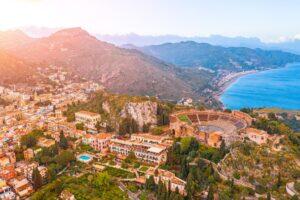Fodor's Expert Review Villa Palagonia
Probably the most intriguing of all Bagheria's villas is the Villa Palagonia, which can either be viewed as a delightful flight of whimsy or the product of a disturbed mind. The villa was erected in 1705 by Francesco, Prince of Palagonia, and his architect, Tommaso Napoli, but what makes it stand out today is the work of Francesco's grandson, Ferdinando, a hunchback who commissioned a weird assembly of sculptures depicting monsters and bizarre figures said to be caricatures of his wife's lovers. Visitors will see a parade of them on either side of the front and back entrances as well as atop the walls of the surrounding garden, a grotesque gallery of monsters, gnomes, and gargoyles. Only 64 of the original statues remain—they are once said to number 200—and these are in a poor state of repair.
You'll find the same air of dereliction when you climb the once-grand double staircase to enter the palace itself, where only five rooms are currently open to the public. Most striking... READ MORE
Probably the most intriguing of all Bagheria's villas is the Villa Palagonia, which can either be viewed as a delightful flight of whimsy or the product of a disturbed mind. The villa was erected in 1705 by Francesco, Prince of Palagonia, and his architect, Tommaso Napoli, but what makes it stand out today is the work of Francesco's grandson, Ferdinando, a hunchback who commissioned a weird assembly of sculptures depicting monsters and bizarre figures said to be caricatures of his wife's lovers. Visitors will see a parade of them on either side of the front and back entrances as well as atop the walls of the surrounding garden, a grotesque gallery of monsters, gnomes, and gargoyles. Only 64 of the original statues remain—they are once said to number 200—and these are in a poor state of repair.
You'll find the same air of dereliction when you climb the once-grand double staircase to enter the palace itself, where only five rooms are currently open to the public. Most striking of these is the Salone degli Specchi, a large hall whose domed ceiling is covered in mirrors, now cracked and fogged. Along the marbled walls here and in other rooms are arrayed flamboyant busts, faded frescoes, and trompe l'oeil effects that recall the grandeur that the villa must once have embodied, though you'll come away with a sense of wistful regret that more care has not been taken to restore and maintain this peculiar place.
READ LESS








